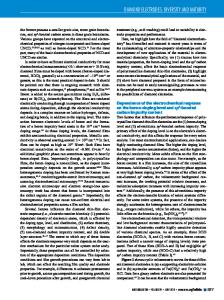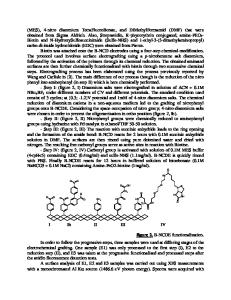Charge-transfer doped intrinsic diamond electrochemical electrodes
- PDF / 457,165 Bytes
- 6 Pages / 612 x 792 pts (letter) Page_size
- 33 Downloads / 406 Views
Charge-transfer doped intrinsic diamond electrochemical electrodes
Waileong Chen1, Chiuan-Yi Li2, ShoupuYeh2 , Shin-Hung Yei1, Yonhua Tzeng1,2 1 Institute of Microelectronics 2 Institute of Nanotechnology and Microsystems Engineering National Cheng Kung University No.1, University Road Tainan City 701, Taiwan (R.O.C.) ABSTRACT We report electrochemical characteristics of hydrogen terminated charge-transfer doped intrinsic microcrystalline diamond films. Microcrystalline diamond was synthesized by DirectCurrent Plasma Enhanced Chemical Vapor Deposition (DC-PECVD) in methane diluted by hydrogen. The diamond films were subjected to further treatment by microwave plasma in pure hydrogen to increase the hydrogen termination of the diamond surfaces and their negative electron affinity. When the diamond is exposed to the ambient moisture, valance electrons tend to tunnel from the first few atomic layers of the diamond surface to the adsorbed water adlayer. This charge transfer process results in the surface of hydrogen-terminated diamond behaving like a p-type semiconductor. Electrochemical characteristics of hydrogen-terminated diamond films were exposed to an air plasma for depleting the surface hydrogen atoms and then re-hydrogenated the same diamond films with atomic hydrogen. Cyclic voltammetry in 0.1M H2S04 aqueous solution and 0.01M Fe(CN)6-4/-3+0.1M KCl aqueous solution was applied to reveal high current density and wide potential window for hydrogen-terminated diamond grown on silicon substrates. The faceted surface morphology has been observed by SEM. The crystalline characteristics and carbon phases in the diamond film were examined by Raman spectroscopy. INTRODUCTION Diamond is a wide band-gap semiconductor that possesses a wide spectrum of extreme electronic, thermal, optical, mechanical, and chemical properties which are desirable for electronic devices operating in harsh aqueous environments and at high-power and high-frequency [1-3]. Semiconductor diamond is therefore considered for electrochemical applications such as water treatments [4,5], bio-sensors [6], and PH meters [7]. Like silicon, diamond can be doped with impurities to become a semiconductor [8-10]. When it is doped with boron, p-type diamond is formed. On the other side, although being a deep level donor, diamond doped with nitrogen exhibits some n-type diamond properties, especially at high temperatures. Diamond films have been deposited by means of a number of methods such as hot filament-chemical vapor deposition (HF-CVD), microwave plasma enhanced CVD (MW-PECVD), and direct-current plasma enhanced CVD (DC-PEDVD) in hydrocarbons such as methane (CH4) and ethane(C2H6) diluted by hydrogen.[11-16]. Intrinsic diamond is a good electrical conductor. When its surface is terminated with atomic hydrogen, diamond exhibits negative electron affinity of about -1.1 eV. When an electro-negative adlayer such as lightly acidic water in the atmosphere is adsorbed on top of a hydrogen terminated diamond surface with negative electron affinity, the valence b
Data Loading...











